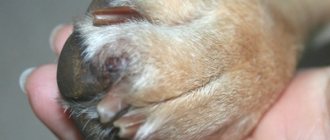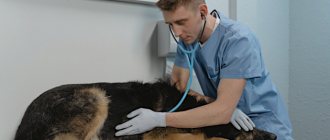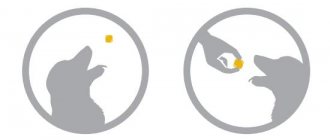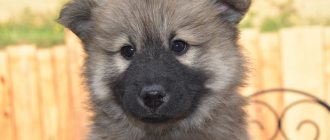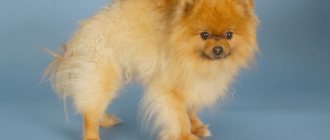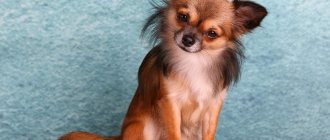Alopecia in Spitz is a fairly common occurrence. Veterinary reference books are laconic and evasive on this issue: the reasons have not been established. Therefore, alopecia in Spitz is often called “alopecia X” (other names are black skin disease, BSD, alopecia X). The best nurseries in the world are puzzled by the search for solutions to the problems of alopecia.
As a veterinarian who has been breeding Pomeranians for many years, I will share my observations on this issue. As a rule, alopecia in a Spitz is a consequence of errors in feeding, improper care of the coat, and neglect of walks. Males get sick more often than females. But in order.
Features of the disease
Alopecia in Spitz dogs is quite common. It can develop at any age. Males are more susceptible to the disease than females.
Doctors have long been studying the question of why Spitz hair suddenly begins to fall out and, based on observations, they identify 3 critical periods in a dog’s life:
- 10-12 months;
- 2-5 years;
- 9-10 years.
Starting from 4 months, the puppy’s fluff begins to gradually be replaced by real hair. The process takes up to 9-12 months. If by 10-15 months the coat does not change, guard hairs do not appear, but there is only fluff, alopecia is suspected. Over time, the cotton-like fluff falls out, and new fur does not appear. The skin darkens, becomes dark gray, closer to black.
In the second group, the coat change occurs successfully and on time. However, at 2-3-4 years old, Spitz baldness begins to appear: bald areas appear on the body, legs, and the skin changes color. The remaining fur becomes rough and dry. Hairs are easily pulled out.
At 9-12 years old, the same signs of the disease appear.
Molting process
Pomeranians, like other purebred dogs, are prone to seasonal shedding. During this process, dead tissue is replaced with new ones - the hair falls out, while making room for fresh hair. The processes of hair loss in Pomeranians are long and intense. During this time, the pet is capable of losing about half the size of its fur coat. There are a number of subtypes of molting: seasonal, age-related and hormonal.
Shedding is seasonal
Under the influence of hormones released in the pituitary gland in response to changing weather conditions, hairs begin to fall out. This occurs between the seasons - in the spring and autumn months. Before the onset of the warm season, Spitz sheds their soft down, and by autumn they free themselves from long hair so that there is free space for a warm fur coat. It has been noted that in dogs that rarely go outdoors, shedding occurs smoothly throughout the year.
Shedding age
When Pomeranian puppies reach four months of age, their first molt occurs. The soft pile of the fluff changes to coarse wool, and it is quite possible that the color of the pet will change. First, the fuzz on the dog’s face disappears, then on the body, and finally the surface of the collar and panties of the hind limbs becomes clear. At the same time, the process proceeds slowly or rapidly.
Under conditions of rapid molting, especially if the animal grows up quickly, the fluff is removed suddenly and the new appearance can shock the owners. This period of coat change occurs when the pet is one year old, and may turn out to be a gradual continuation of the puppy’s molting. Only the sprouted undercoat can fall off within three months, leaving room for coarse hair to grow. The dog acquires the usual appearance of a classic orange at the age of two.
Shedding is hormonal
Female Pomeranians have a tendency to experience excessive hair loss during estrus. In the situation of giving birth to offspring, the female may develop noticeable bald patches, or almost complete hair loss. In the meantime, it is important to provide the dog with a balanced diet and monitor the full range of beneficial elements in the diet.
Hair loss can be caused by hormonal imbalance. It is advisable to highlight the signs of real problems:
- The appearance of bald patches around the dog’s genitals indicates an excess of physiologically active steroids in the body.
- In rare cases, a sterilized female can boast a healthy coat; a deficiency of female sex hormones makes the hair weak and inhibits its growth.
- Excessive, sudden hair loss can be caused by excess cortisol.
- In cases of dysfunction of the endocrine system, the hair becomes thin and comes out in the chest area and on the back of the pet.
Experienced dog lovers know the details of the daily maintenance of Spitz fur. An experienced breeder is able to preserve the shine of the fur even at the moment of rapid molting.
Causes of baldness
Active hair loss, known as alopecia X, has many names in veterinary circles:
- black skin disease (BSD or BSD);
- castration-responsive alopecia;
- biopsy-responsive alopecia;
- growth hormone deficiency in adult dogs.
The problem is that the cause of the disease is still not clear. The most common theory is that disruption of the hormonal metabolism of hair follicles leads to disruption of the hair growth cycle. But it has not yet been possible to determine which gene is responsible for the pathology.
Sterilization and castration
There is a theory that this pathology does not develop in animals that have undergone these procedures. Therefore, first of all, the specialist will suggest the pet owner to perform this type of operation.
As a rule, such events often help stop subsequent baldness of pets. Gradually, on the skin that was completely bare, first an undercoat will begin to appear, and then a full-fledged coat.
You need to be patient, because recovery takes quite a long period of time, sometimes several months.
Symptoms of BSD
Alopecia in a Spitz develops gradually, the following signs appear:
- At first, the coat becomes dry, seems lifeless, dull. There is no itching.
- The undercoat is also dry and not shiny.
- At the same time, the hair falls out in places: bald spots appear in the area of the croup, neck, hips, abdomen, and the tail becomes bald.
- The guard hairs are the first to be lost. The undercoat gradually falls out.
- The whole body may go bald. In this case, the head, hair around the eyes and paws are not affected.
- The skin changes color and becomes dark. It often peels off and is prone to the formation of small pustules. On the abdomen, the skin atrophies, becomes thin, inelastic, and comedones appear.
The photo shows what a hairless Spitz looks like.
The hairless Spitz feels good, there are no deviations in his health. However, open areas are dangerous because they can become infected and become inflamed.
Things to consider
With alopecia, there is no itching and the skin does not look inflamed. The animal does not suffer from pain or any discomfort. First, the loss of long, coarse hair occurs. After this, the undercoat is exposed, which also disappears a little later.
If the pathology is advanced and the owner of the animal does not take any measures, then after a while the dog’s skin will begin to coarse and gradually darken. If it has reached the very last stage, then the hair may remain only on the head.
Diagnostics
If your Spitz begins to go bald, you should immediately contact a veterinarian with a dermatologist profile. A diagnosis of BSD alopecia can be made only in 1 case - if we exclude other possible reasons why a Spitz's coat is thinning: hypothyroidism, Cushing's syndrome, hyperestrogenism, inflammation of the sebaceous glands (sibadenitis). Therefore, you may also need to see an endocrinologist.
One of the reasons why a Pomeranian can go bald is Cushing's syndrome. This is an endocrine disease. The reason is the excess content of the hormone cortisol. Symptoms develop gradually. The dog has:
- frequent urination, thirst;
- profuse hair loss in the neck, tail, and body;
- the dog loses weight;
- the muscles become weaker, the stomach sags.
Spitz also goes bald with a disease such as hypothyroidism. A fairly common disease that is caused by a deficiency of thyroid hormones. Hypothyroidism is characterized by:
- lethargy, rapid fatigue;
- weight gain;
- the skin becomes cold, feels tight and thick;
- The coat on the back and sides is damaged.
Moreover, the first signs are baldness of the tip of the tail (“rat tail”) and the back of the nose. Hair falls out in the groin and axillary areas, on the neck in the collar area. After shearing, the hair grows poorly or does not grow at all. Pigmented areas of skin devoid of hair appear. Diagnosis of hypothyroidism is complicated by the fact that not all clinics have the opportunity to analyze the levels of several hormones at once. If the diagnosis is correct, treatment of the disease is successful.
Alopecia X is most often mistaken for hypothyroidism. Therefore, serious diagnosis is necessary.
Appointed:
- blood and urine tests;
- thyroid examination;
- determination of hormonal levels;
- skin biopsy.
If the Spitz is bald, but a general and biochemical blood test shows no changes or disturbances in the functioning of internal organs and systems, there are no signs of inflammation on the skin, itching, endocrine pathologies are excluded, a diagnosis of alopecia X is made.
Skin examinations show the following:
- Most follicles are in the resting (telogen) stage.
- Thickening of the stratum corneum of the epidermis (hyperkeratosis).
The prognosis for alopecia in a Spitz is as follows: if hair has fallen out, then despite possible remissions, complete hair restoration does not occur.
Prevention
Constantly following the recommendations of veterinarians and Spitz breeders helps owners avoid alopecia in their dogs.
- Quality food. It is necessary to feed your Spitz with premium, super-premium commercial ready-made food, or a fully balanced diet of fresh products prepared independently. When feeding natural food, it is necessary to take into account all the dog’s nutritional needs, do not forget about fermented milk products, fresh vegetables and fruits. A Spitz owner can get nutritional recommendations from their breeder or veterinarian.
- Inclusion in the diet of supplements, vitamin and mineral complexes aimed at strengthening the immune system and improving the quality of the coat. Olive oil, omega-3 polyunsaturated fatty acids, fish oil, vitamin E - improve coat and skin, accelerate the shedding process and activate new hair growth. Rose hips, berries, sea fish - restore and support immunity. Pet stores offer ready-made tablet or liquid vitamin complexes for dogs, among which each owner can choose the optimal one for his dog.
- Your Spitz should be washed weekly using moisturizing shampoos and conditioners. Be sure to dry your dog completely and thoroughly to avoid getting the coat wet - this can cause eczema and dermatitis.
- You need to brush your Spitz every day with a massage brush. It is important to comb the wool completely, from the very roots, without leaving tangles. This will accelerate the loss of dead hair and awaken the follicles for active growth of the fur coat. Experienced breeders recommend moistening the Spitz's coat with a moisturizing conditioner diluted with water in a ratio of 1:10 before combing. Particular attention should be paid to combing during the period of shedding - the maximum loss of dead hair. In males, shedding occurs twice a year, in spring and autumn, in females, plus the off-season - before, during or after estrus, pregnancy, the period of feeding puppies
- Timely deworming and vaccination. If the Spitz's body is weakened by parasites, the dog's immunity and overall body resistance are reduced, which means the risk of baldness increases and treatment in this situation will be longer and more complex. Timely vaccination allows you to protect your animal from common infections that are dangerous in themselves and reduce the body’s defenses.
Read Blood tests for dogs: types and interpretation of indicators
Treatment
It is difficult to cure baldness in Spitz dogs due to the fact that the reasons that caused it are not known. However, certain methods have developed in the practice of veterinarians.
If a diagnosis of X alopecia is made, several treatment options are offered:
- Do not treat, but only see a doctor.
- Castration.
- Taking melatonin.
- Use of Trilostane.
- The use of mesoscooters.
Castration
If the animal is not castrated, the first thing that is suggested with a diagnosis of X alopecia is to remove the testicles. Many doctors attribute the problem to an imbalance of sex hormones. In 50% of cases the treatment gives a positive result. Since the proportion of cured dogs is small, chemical castration is recommended. This is when the drug Suprelorin is injected under the skin. It is valid from 6 months to a year. If during this time the baldness of the Spitz has stopped and the coat has begun to recover, then regular castration or a second injection is recommended. A significant disadvantage is that chemical castration costs 2-3 times more than usual, and the cost of the drug itself is high.
Hormone therapy
If X alopecia began in a sterilized Pomeranian or castration did not produce results, then in most cases melatonin is recommended. This is one of the safest methods of drug therapy. The course is long, designed for 2-3 months.
The dog is given 1 tablet (1 mg) 3 times a day. If the dynamics of melatonin treatment is positive, the dose is reduced to 1 tablet twice a day. The animal is being watched. If there is no deterioration in the condition of the coat, switch to the regimen - 1 tablet once a day. The dosage and number of doses are individual and determined by the attending physician.
It is noted that the first improvements occur within 1.5 months after the start of treatment. Melatonin is contraindicated for Pomeranians with diabetes. Of the side effects, there is only one - the pet’s drowsy state.
Trilostane demonstrates effective treatment but has many side effects. In addition, alopecia in Spitz often returns despite therapy.
The use of medroxyprogesterone is another way to treat alopecia in Pomeranians. In 50% of cases, the use of the drug gives a positive result. The product is administered subcutaneously once a month. A total of 4 injections are given.
Mesodermorollers
It has been noted that in damaged areas of bald skin where hair has come out, hair may begin to grow again. Doctors note this after taking a biopsy. And there is an assumption that gentle mechanical trauma to the skin can stimulate new hair growth. Therefore, alopecia X is treated using a multi-needle dermoroller. The device is a drum with protruding needles. When drumming, many tiny punctures appear on the skin. The skin becomes irritated and the process of renewal and regeneration begins.
Melatonin
Doctors use this hormone to rid an animal of alopecia. As a rule, this medication is used if other therapeutic measures have not had the desired effect.
If more than 4 months have passed after castration or sterilization, and the pet still suffers from baldness, then melatonin is used in this case. It is administered subcutaneously. The course of treatment is quite long, can take up to 3 months. Typically, the hormone is administered until the doctor notices that the hair has begun to grow again. It is very important not to interrupt the course of treatment under any circumstances, since in this case all injections will be useless.
Alopecia after haircut
Owners often sound the alarm, horrified that the Spitz has begun to go bald after being clipped. Groomers explain this as follows: when cutting with a clipper, the hairs are cut off at the root. There are many stumps left that cannot completely fall out during molting. With each cutting, there are more stumps. Hair follicles cannot fully form as there is less and less space. The bulbs become thinner, smaller and, accordingly, the hairs from them grow weak and thin.
Veterinarians think differently. If a dog has a predisposition to BSD, haircut (even short), combing, and food do not affect the development of alopecia.
Methyltestosterone
In this case we are talking about a synthetic hormone. However, it should never be used if the animal suffers from Cushing's disease or hypothyroidism. In this case, there is a risk of worsening the skin condition. In all other respects, this drug is quite effective and helps restore the coat.
If this remedy also does not help, then the doctor may prescribe Lysodren (the drug destroys secretory cells located in the animal’s adrenal glands) or other drugs.
As a rule, hormonal medications are used to treat such pathologies, which are most often administered subcutaneously. With this type of treatment, the skin and coat often recover within a few months.
Basics of training
First of all, you need to accustom the puppy to his name, calling it during rewards. Pomeranians remember their name very easily.
- The next task is litter box training. Puppies quickly become accustomed to proper hygiene, but a little patience is required at first.
First, they place several trays where the baby relieves himself; for the smell, you need to leave diapers soaked in the puppy’s urine in them, which are periodically replaced.
After a few days, the trays are washed and gradually moved to a corner designated specifically for the toilet. After another 7-8 days, the excess trays are removed.
To quickly accustom your baby to the toilet, you need to put him there after eating and sleeping. If he sniffs and searches, take the baby to the tray. After the “deed”, praise and treat him with something delicious.
How to deal with shedding in Spitz dogs
Why do cats sleep a lot: the main reasons and is it normal?
The most popular question asked to breeders is whether a Spitz has a lot of hair. People often think that during shedding, the whole house is covered in animal fluff. However, if you brush your pet regularly, all the fallen hairs will end up on the bristles of the slicker.
During the procedure, it is worth placing the animal on a special table for grooming or any other device separately designed for this. After combing, it is recommended to vacuum the room so that the wool does not fly around the apartment.
Owner reviews
Violetta: “I never wanted to cut my dog’s hair short, because, in my opinion, such hair is unpleasant to the touch. We once had our ponytail cut short, and at the slightest tactile contact it was noticeable that the smoothness that, say, was on the back had disappeared.”
What and how many times to feed a Spitz - diet analysis
Sasha: “The most amazing thing is that after combing a huge mountain of fur, my dog only becomes fluffier. And even easier. The groomer said that you shouldn't put a harness on a Pomeranian because it creates more tangles in the armpits. But I think it’s better to have tangles than to torment my baby with a collar or a noose.”
Parasites
Various worms that have found refuge in the dog’s digestive system release harmful substances that provoke permanent poisoning in the animal. In addition, uninvited guests absorb nutrients, creating their deficiency in the Spitz's body.
Mites living on the surface of the skin or a fungal infection usually provoke itching and, as a result, wounds and scratching. Hair falls out. Bald spots may appear, in some cases covered with crust or scales.
Command training
Given the aggressive and impulsive nature of Pomeranians, discipline is mandatory for them along with active walks. You need to control the animal’s behavior by training it to basic commands:
- "Give!" The pet is easy to learn while playing with the ball. Before you take the toy from him, you need to say the command and praise the puppy.
- "To me!". When walking with a leash, call the dog if it is not busy. The puppy turns towards the voice, slightly pulls the reins and calmly says the command again. Praise after completion.
- “Ugh!”, “No way!” – puppies older than 6 months can be trained to use commands, as they frighten babies. Show the meaning with a sharp, intimidating intonation while pronouncing the command, accompanying it with a jerk of the leash. The movement should not injure the dog.
- "Near!" – learned during a walk, you need to lead the Spitz on a short leash on your left side. When he tries to move to the side, pull him a little towards you, say a nickname and a command. Maintain a calm tone and do not jerk the leash sharply.
- "Place!" needs to be taught in the first months of life. Say the command with praise and pet the puppy when he goes to his bed after eating. If the Spitz decides to settle somewhere else, say the command and take him to his place. It should be arranged so that the baby feels comfortable and protected, this promotes quick memorization.
All commands, except for the prohibiting one, must be spoken in a gentle tone, otherwise the dog will perceive them as punishment. If done, praise and treat with a treat.
A Pomeranian Spitz is suitable for active owners - the puppies are very active, willingly spend time with their owner, become attached to him and become true friends.
Basic procedures
Grooming consists of combing, washing and cutting; Each procedure has its own frequency and characteristics. After each manipulation of the fur, reward the dog with a treat, especially if it behaved well.
Photo: wikimedia.org
Combing
Regularity: once a week - for a short-haired dog, twice a week - if the Spitz is uncut. Rain while walking is a reason for extra brushing.
Means: combs with teeth of different frequencies, massage brushes - do not damage the hair and do not cause pain to the dog; conditioner and spray - make combing easier and improve appearance. Select the frequency of the teeth so that it does not allow tangles to pass through, but also does not pull out hairs. Do not use powder brushes: they injure the skin and cause inflammation.
Procedure: carried out at home, on a table, the dog should lie on its side; For the first time, you can brush the puppy on your lap. Mats often form in the groin, under the jaw, near the front legs and behind the ears. Pay attention to these places first. You need to brush in the direction from the tail to the head, against the growth of the hair - this way the skin is better aerated (especially important for wet wool). At the end, fluff the fur with your fingers - this way it will remain fluffy and stuffed longer. If your dog has problem hair, you have neglected it, cut the mats yourself. If you will be participating in an exhibition in the near future, it is better to contact a professional groomer: perhaps he will be able to untangle the tangles with the help of anti-tangle products.
If you have aggression when scratching, watch this video.
Bathing
Regularity: once every 1-2 months and outside the schedule before the exhibition.
Products: Use dog cosmetics for washing. Human (even expensive and well-known) shampoos are not suitable for this purpose.
How to choose dog cosmetics:
- one brand for shampoo, antistatic agent and conditioner,
- hypoallergenic,
- special bleaches - to whiten the areas under the eyes of white Spitz dogs,
- powdered, dry shampoos for animals that do not like to bathe.
Procedure: carefully plug the dog's ears with cotton swabs to prevent water from getting into them, dilute the shampoo and conditioner separately with water, wet the skin well with warm water, distribute the shampoo, lather, rinse. Treat the washed fur with conditioner and rinse. Wash your Pomeranian only after brushing.
Drying
Regularity: Be sure to dry the fur after each bath. Deep in the orange skin, which remains wet for a long time, an environment favorable for bacteria and fungi is created.
Remedies: do not just leave your dog to dry, be sure to use a hairdryer, which you will have to gradually accustom the animal to.
Procedure: First thoroughly dry (but do not rub!) the dog with a large towel, then dry with a hairdryer, lifting the hairs with a comb and directing warm air to their base. Dry wool needs moisturizing: apply a moisturizer to the under-dried coat and let it dry.
A haircut
Regularity: haircut is necessary occasionally: as needed to remove tangles, and before the exhibition. In any other case, it is not necessary to trim the Pomeranian's coat.
Procedure: the fur is trimmed, overgrown (usually by 1.5-2 years) pieces on the sides are removed, the ears are shaped, outside and inside. Trimmed fur looks more well-groomed.
You can cut your hair for the first time when your Pomeranian is 3 months old. Most often, Pomeranian owners choose the Mouton haircut. Never shave your Pomeranian head!
Puppies
Spitz puppies have thinner skin, so they require more careful grooming. If dandruff appears, you need to wash the puppy every three days and then thoroughly moisturize the coat. Shampoo must be used medicinally to effectively remove skin secretions.
Just in case, you can treat the puppy’s fur with a special preparation called Stronghold. It destroys many types of external parasites and is safe for the animals themselves, as well as their young. It is very important to follow the dosage of this product and use it according to the attached instructions.
If, in addition to dandruff, the puppy has other serious symptoms (severe itching, unpleasant odor, baldness), you should immediately show the dog to a specialist to prescribe more appropriate treatment, taking into account the characteristics of the pet.
Important! Don't delay visiting the veterinarian! Who else, if not him, will determine the exact cause of dandruff and prescribe the correct treatment. Spitz puppies have thinner skin and a weaker immune system, so they are more susceptible to various types of parasites and diseases.
Is it dangerous
The lack of fur in oranges leads to disruption of thermoregulation. There is nothing stopping ultraviolet radiation from having a harmful effect on a dog’s skin. The dog becomes susceptible to drafts and precipitation. The skin stops secreting a secretion that is intended to lubricate the hair and epidermis.
Additional Information. Skin repeatedly exposed to sunburn becomes a target for malignant lesions and neoplasms. Not protected by thick fur, a Spitz often suffers from colds and pneumonia.

